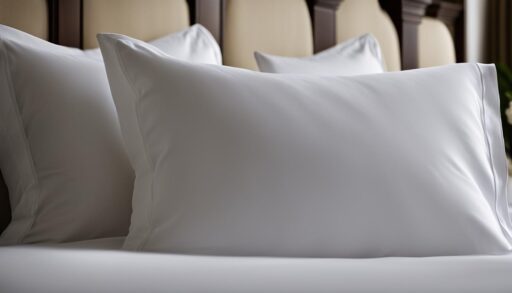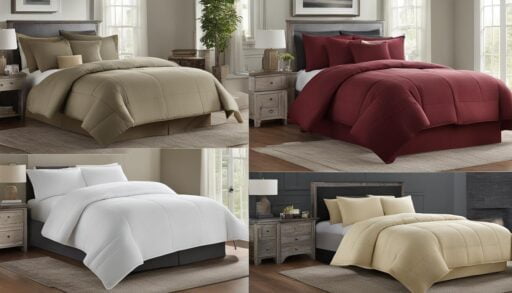Best Time to Buy Bedding and What Bedding is Best for Sleep
Welcome to our guide on the best time to buy bedding and the best bedding to sleep in. Whether you’re looking for a new set of sheets, cozy blankets, or fluffy pillows, we’ve got you covered with valuable shopping tips and insights. Getting a good night’s sleep is essential, and having the right bedding can make all the difference in your comfort and well-being. So, let’s dive in and discover the optimal times to snag great deals and find the perfect bedding for your sleep sanctuary.
Key Takeaways:
- The best time to buy bedding and linens is during the January “White Sales” when retailers offer discounts of up to 80%.
- August is another opportune time to purchase bedding, especially for college students, as retailers offer discounts to attract them.
- Black Friday and Cyber Monday sales in November also provide opportunities to find deals on bedding, although the discounts may not be as steep as the January White Sales.
- Late summer, particularly in August, is the optimal time to buy sheets and towels during end-of-summer and back-to-school sales.
- Signs that it’s time to replace sheets and towels include fraying, fading colors, thinning fabric, diminished absorbency, and stubborn stains or odors.
With these valuable insights, you’ll be well-equipped to make informed decisions when it comes to bedding shopping. Stay tuned for more sections where we explore the history of the “White Sale,” summer discounts, and the best times to buy sheets and towels. Let’s create a sleep haven that’s both comfortable and stylish!
The History of the “White Sale” and the Best Month to Buy Linens
The concept of a “White Sale” dates back to the 19th century and was started by a man named John Wanamaker. The name comes from the fact that linens at the time were predominantly white. Wanamaker began holding his sales in January, and many retailers have continued the tradition ever since. January is considered the best month to buy linens, as retailers offer discounts on their leftover inventory from the holiday season. February may also offer discounts, but the selection may be more limited. March, specifically during Sleep Awareness Week, can also be a good time to buy bedding.
During the “White Sale” in January, retailers offer a wide range of linens including sheets, pillowcases, duvet covers, and towels at discounted prices. This is the perfect opportunity to refresh your bedding and bath essentials without breaking the bank. Whether you prefer crisp white sheets or colorful patterns, you’re likely to find great deals during this time.
It’s worth mentioning that the “White Sale” tradition has expanded beyond January. Many retailers now offer discounts on linens throughout the year, especially during major shopping events like Black Friday, Cyber Monday, and Back-to-School sales in August. However, if you’re looking for the deepest discounts and widest selection, January is still the best month to buy linens.
Best Month to Buy Linens
| Month | Discounts | Selection |
|---|
| January | High | Wide |
| February | Moderate | Limited |
| March | Moderate | Moderate |
As the table above shows, January offers the highest discounts and widest selection of linens. While February and March may still have some discounts available, the selection may be more limited. So, if you’re in need of new linens, mark your calendars for January and take advantage of the “White Sale” tradition.
Discounts on Bedding and Linens During the Summer Months
If you’re looking to save money on bedding and linens, the summer months can be a great time to shop. August, in particular, offers discounts on bedding, especially for college students gearing up for the new school year. Many retailers provide deals on inexpensive and modest bedding options, making it the perfect time to refresh your sleeping essentials.
During this period, keep an eye out for discounts on bedding and linens specifically tailored for students moving into dorms and apartments. However, it’s important to note that these discounts may not be as prevalent at specialty stores or high-end retailers. Nonetheless, the savings can be significant, making it worthwhile to explore different options.
Additionally, another opportunity for savings can be found during Memorial Day weekend in May. Some retailers offer discounts on bedding and linens as part of their holiday sales. While the discounts might not be as extensive as those during the January White Sales or back-to-school promotions, it’s still a chance to snag a good deal if you’re in the market for new bedding.

Whether you’re a student or simply looking to refresh your bedding, taking advantage of the summer discounts can help you save money while still ensuring a good night’s sleep. So mark your calendar for August and keep an eye out for Memorial Day promotions to score some fantastic deals on bedding and linens.
Deals on Bedding and Linens during Black Friday and Cyber Monday
Black Friday and Cyber Monday, which occur in November, offer excellent opportunities to score deals on bedding and linens. Many retailers, both big box stores and high-end retailers, participate in these sales events, making it a great time to purchase new bedding. While the discounts during these sales may not be as steep as those offered during the January White Sales, they can still provide significant savings.
During Black Friday and Cyber Monday, retailers often offer discounts on a wide range of bedding and linens, including sheets, comforters, pillows, and towels. You can find deals on popular brands as well as more affordable options. Whether you’re looking for luxury bedding or budget-friendly options, there are deals to suit every budget and style preference.
To make the most of the Black Friday and Cyber Monday sales, it’s a good idea to plan ahead. Research the products you’re interested in and compare prices from different retailers. Create a list of the specific items you need and keep an eye out for promotions and discounts leading up to the sales events. Additionally, consider signing up for retailer newsletters or following their social media accounts to stay informed about any exclusive deals or early access offers.
Black Friday and Cyber Monday Bedding Deals Highlights
| Brand | Product | Original Price | Discounted Price |
|---|
| XYZ Bedding | Luxury Queen Sheet Set | $199 | $139 |
| ABC Linens | King Size Comforter | $149 | $99 |
| DEF Home | Plush Pillows (Set of 2) | $59 | $39 |
| GHI Bath | 6-Piece Towel Set | $49 | $29 |
Remember to act fast during the Black Friday and Cyber Monday sales, as popular items tend to sell out quickly. Keep in mind that while the focus of these sales events is typically on electronics and gadgets, there are still plenty of fantastic deals to be found in the bedding and linens department. Whether you’re looking to upgrade your sheets, refresh your towels, or revamp your bedroom decor, Black Friday and Cyber Monday are prime times to snag great deals on quality bedding and linens.
Best Time to Buy Sheets and Towels
If you’re in the market for new sheets and towels, timing your purchase can save you some money. The best time to buy sheets and towels is typically in late summer, particularly in August. During this time, many retailers offer end-of-summer and back-to-school sales, making it a great opportunity to snag some deals on these essential home items.
Another optimal time to buy sheets and towels is during the traditional “White Sales” that happen in January. These sales are a long-standing tradition and typically occur after the holiday season. Retailers offer discounts on bedding and linens during these sales, making it an excellent time to stock up on fresh sheets and fluffy towels.
Aside from these specific months, keep an eye out for other sales events that could offer discounts on sheets and towels. For example, Amazon Prime Day in July and Black Friday sales in November often feature deals on home goods, including bedding and bath linens. Taking advantage of these sales can help you score quality sheets and towels at more affordable prices.
Remember, when shopping for sheets and towels, consider factors such as fabric type, thread count, and personal preferences. And don’t forget to check the care instructions for proper maintenance. By timing your purchase right and being mindful of the details, you can ensure you’re getting the best sheets and towels for your home.

Comparison of Best Times to Buy Sheets and Towels| Month | Events/Sales | Discounts |
|---|
| August | End-of-summer and back-to-school sales | Opportunity to snag deals |
| January | White Sales | Discounts on bedding and linens |
| July | Amazon Prime Day | Possible deals on home goods |
| November | Black Friday sales | Opportunity for discounts |
Signs that It’s Time to Replace Sheets and Towels
Knowing when to replace your sheets and towels is essential to maintaining optimal comfort and functionality. Here are some signs that indicate it’s time to invest in new bedding and linens:
- Fraying or Holes: If you notice fraying edges or holes in your sheets or towels, it’s a clear indication that they have reached the end of their lifespan. These imperfections can compromise the fabric’s integrity and affect their performance.
- Fading Colors: Over time, frequent washing and exposure to sunlight can cause sheets and towels to lose their vibrant colors. If you notice significant fading, it may be time to refresh your collection.
- Fabric Thinning: Sheets and towels experience wear and tear with regular use. If you can see through the fabric or notice that it has become thin and transparent, it’s a sign that replacement is necessary.
- Loss of Absorbency: Towels are designed to be absorbent, but over time, repeated washings can diminish their ability to soak up moisture. If your towels are no longer drying you off effectively, it’s a good indication that they need to be replaced.
- Stains or Odors: Stubborn stains or lingering odors that persist even after washing are signs that your sheets and towels have accumulated dirt, bacteria, or other contaminants that cannot be fully removed. It’s best to replace them to maintain hygiene.
By recognizing these signs, you can ensure that you always have fresh, high-quality sheets and towels that contribute to a cozy and hygienic sleeping and bathing experience.

Tips for Buying and Caring for Sheets and Towels
When it comes to buying sheets, there are a few tips to keep in mind. Firstly, consider the fabric type. Cotton sheets blended with synthetic fabrics offer a great balance of durability and affordability. However, if you’re looking for sheets that will last longer and become softer with each wash, opt for 100% linen sheets. Secondly, pay attention to the thread count. A higher thread count doesn’t always mean better quality, so focus on finding sheets with a thread count between 200 and 400 for optimal comfort. Lastly, consider your personal preferences in terms of texture and feel.
Now, let’s move on to towels. When buying towels, think about the fabric type. Turkish cotton towels are often recommended for their luxurious feel and high absorbency. Pay attention to the stitching as well, as towels with reinforced edges tend to be more durable. Size and density are important factors too, so choose towels that suit your needs. If you prefer lightweight and quick-drying towels, opt for thinner ones. If you prefer plush and absorbent towels, go for thicker ones.
After you’ve made your purchases, it’s important to care for your sheets and towels properly to ensure their longevity. Wash them separately from other items to prevent damage, and treat any stains promptly to avoid permanent marks. Follow the fabric-care instructions provided by the manufacturer, as they will guide you on the appropriate washing and drying methods. By properly caring for your sheets and towels, you’ll be able to enjoy their comfort and functionality for a longer period of time.
FAQ
What is the best time to buy bedding?
The best time to buy bedding is during the January “White Sales” when many retailers offer discounts of up to 80% on bedding and linens. August is also a good time to buy bedding, particularly for college students. Additionally, bedding is often included in Black Friday and Cyber Monday sales in November.
When did the concept of the “White Sale” start?
The concept of the “White Sale” dates back to the 19th century and was started by a man named John Wanamaker. The name comes from the fact that linens at the time were predominantly white. Wanamaker began holding his sales in January, and many retailers have continued the tradition ever since.
When is the best month to buy linens?
January is considered the best month to buy linens, as retailers offer discounts on their leftover inventory from the holiday season. February may also offer discounts, but the selection may be more limited. March, specifically during Sleep Awareness Week, can also be a good time to buy bedding.
Are there discounts on bedding during the summer months?
Yes, August is a good time to buy bedding and linens, especially for college students as they prepare to move into dorms and apartments. Many retailers offer discounts on inexpensive and modest bedding options during this time. Memorial Day weekend in May is another time to look out for discounts on bedding and linens.
Are there deals on bedding during Black Friday and Cyber Monday?
Yes, Black Friday and Cyber Monday, which occur in November, offer opportunities to purchase bedding and linens at discounted prices. Big box stores tend to have the best sales, but high-end retailers may also offer discounts during this time.
When is the best time to buy sheets and towels?
The best time to buy sheets and towels is typically in late summer, particularly in August, when many retailers offer end-of-summer and back-to-school sales on these items. January during the “White Sales” is also a good time to buy sheets and towels. Amazon Prime Day in July and Black Friday sales in November are also good times to find deals on sheets and towels.
How do I know when it’s time to replace sheets and towels?
Signs that it’s time to replace sheets and towels include fraying or holes in the fabric, fading colors, fabric thinning, towels losing absorbency, and stains or odors that don’t come out in the wash.
What should I consider when buying sheets and towels?
When buying sheets, consider factors such as fabric type, thread count, and personal preferences. When buying towels, consider factors such as fabric type, stitching, size, density, and personal preferences. Carefully check the stitching and care instructions on the sheets and towels before purchasing.
How should I care for sheets and towels?
To care for sheets and towels, wash them separately, treat stains promptly, and follow the fabric-care instructions provided. This will help maintain their quality and lifespan.
Source Links


















